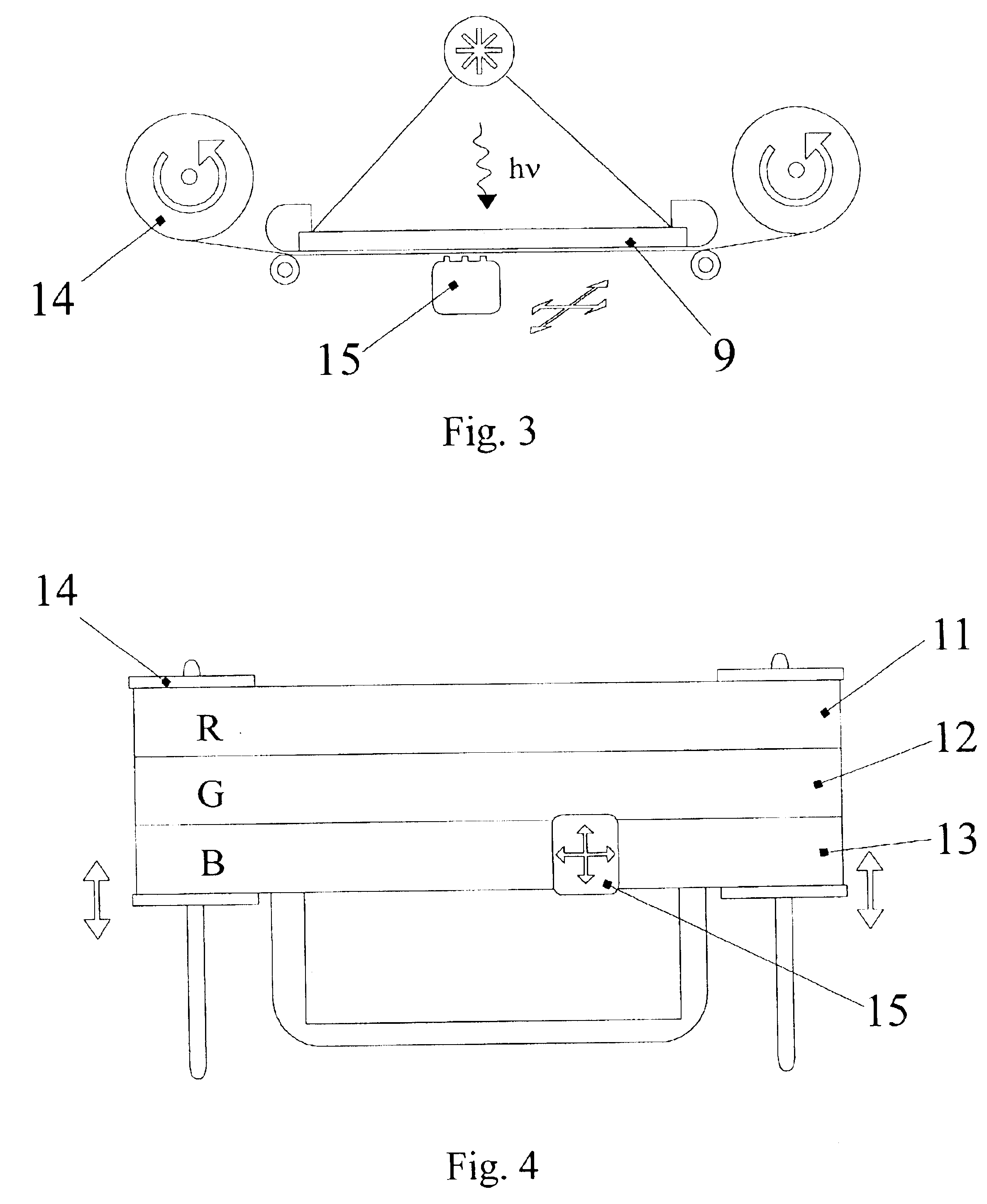Method of fabricating anisotropic crystal film on a receptor plate via transfer from the donor plate, the donor plate and the method of its fabrication
a technology of anisotropic crystal film and receptor plate, which is applied in the direction of diffusion transfer process, photosensitive materials, instruments, etc., can solve the problems of insufficient sharp edge of coating, inability to reproduce the elements of small sizes, and difficulty in incorporating an additional fabrication process to produce films and parts based on the above films. achieve the effect of high degree of anisotropy of film
- Summary
- Abstract
- Description
- Claims
- Application Information
AI Technical Summary
Benefits of technology
Problems solved by technology
Method used
Image
Examples
example 1
[0083]When forming the donor plate on a glass base, the glass plates of suitable size are fabricated first, the surfaces of which are then modified to change adhesion of the polymer film to be applied later. To make the surface of the glass plates hydrophobic, one may use dimehtyldichlorosilane, hexamethyldisilanizan, stearic acid and other agents. Selection of the hydrophobizator is determined mainly by the thin polymer film applied later, which should satisfy the following requirements: be optically transparent, hydrophilic, mechanically strong, smooth, and no thicker than 1000 A. These requirements are met, for example, by films of celluloid obtained via the method of pouring solution of celluloid (for example 1% solution in amylacetate) over the surface of water, or films of PVA, polyvinyl alcohol, (for example 5% concentration), obtained via adsorption of aqueous solutions or centrifuging.
[0084]Next, a colloid solution (liquid crystal) of dichroic dye is prepared and applied on...
example 2
[0093]Consider the following example of the method of fabricating donor plates, used for subsequent creation of color polarizer matrixes (CPM). Creating each color layer of the anisotropic film is performed in two stages. The first stage is to form a continuous anisotropic film on a smooth flat surface of the technological plate. This may be a flexible polymer film or at first a glass receptor from which the anisotropic film will later be transferred onto a flexible polymer film (this way of fabrication is used to increase the quality of fabricated anisotropic films).
[0094]The second stage is to transfer the anisotropic crystal film from the flexible polymer film onto the working surface of the base or any kind of layer of the donor plate, which features a previously formed relief, made from a positive photoresist patterned by photolithography and representing the negative pattern of one color of the CPM. After removing the photoresist via “explosive” photolithography, the remaining...
example 3
[0098]In order to transfer at least a portion of the formed film (note, that the film may be formed not on the base, but transferred onto the base being already finished) from the donor plate onto the polymer receptor, which is transparent in the operational range of wavelengths, the above film is brought into contact with the receptor, the area to be transferred is activated via localized heating to temperature 45-55° C.; most commonly the temperature is in the range 30-50, or 40-65° C. Metallic plate situated under the donor plate can provide localized heating and can provide the foundation for subsequent application of pressure. Heating may continue for 0.5 minute depending on the speed of temperature increase (gradient), under different conditions the heating time may be 0.2-1 min, 1-5 min, 0.5-10 min or other. The regimes of activation and applicable pressure are chosen with the condition that the contrast at the constant transmission and / or birefringence coefficient of the ani...
PUM
| Property | Measurement | Unit |
|---|---|---|
| Fraction | aaaaa | aaaaa |
| Angle | aaaaa | aaaaa |
| Angle | aaaaa | aaaaa |
Abstract
Description
Claims
Application Information
 Login to View More
Login to View More - R&D
- Intellectual Property
- Life Sciences
- Materials
- Tech Scout
- Unparalleled Data Quality
- Higher Quality Content
- 60% Fewer Hallucinations
Browse by: Latest US Patents, China's latest patents, Technical Efficacy Thesaurus, Application Domain, Technology Topic, Popular Technical Reports.
© 2025 PatSnap. All rights reserved.Legal|Privacy policy|Modern Slavery Act Transparency Statement|Sitemap|About US| Contact US: help@patsnap.com



